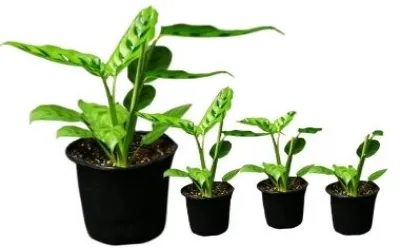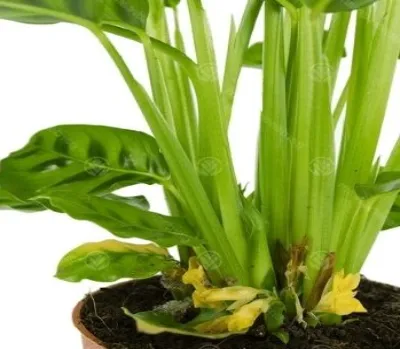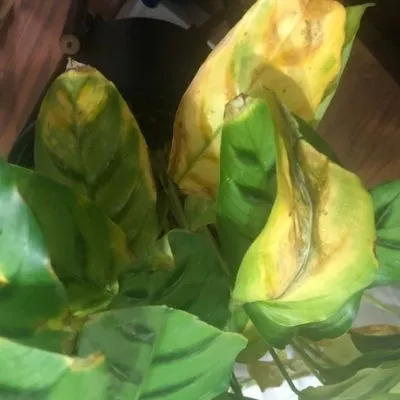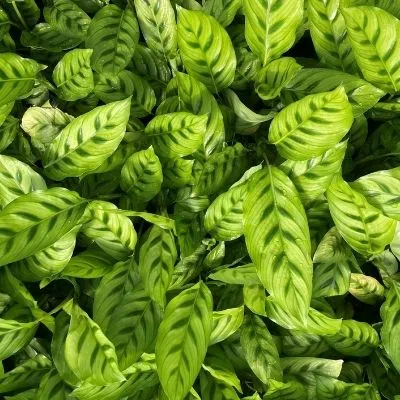How many plant collectors are ready to add a new plant to their massive assortment? Well, I have one extremely impressive recommendation, The Calathea Leopardina or Calathea Concinna, an easy to take care and gorgeous plant from the tropical rainforests of Brazil with remarkable greenery.
The plant has marvelous bright green shovel-shaped leaves with a spotted pattern around the leaf-like a leopard, just like the name. The leaves attach to long, vertical stems that spread outwards in random directions giving a mystical display in any area of your house, whether it is a corner, garden, etc. It’s worth mentioning that taking care of it is just like squeezing a lemon, making it one of the greatest Calatheas for gardeners.
The Calathea Leopardina is mistakenly called Calathea Freddie by plant sellers and owners. Both plants’ foliage seems similar at first glance; however, if you look closely, the green striped pattern on leaves is different from each other. Furthermore, Calathea Leopardina produces yellow flowers in the wild, whereas Calathea Freddie has white. In short, both plants are different species and shall not be treated as the same.
Prominent Family Members: Calathea Makoyana, Calathea Musaica, Calathea Crocata, Calathea Rufibarba, Calathea Ornata, Calathea Orbifolia, Calathea Warscewiczii
Essential Products:
How to take care of a Calathea Leopardina?
The plant does require little attention to flourish. Calatheas are accustomed to the warm and humid temperatures of the rainforest environment, but the Leopardina’s can adapt to many settings, making it easy to take care plant. However, there are some things that you need to know so you can take care of it without messing up. You should know which soil mix how much water, fertilizer, and light it needs. You also need to know the best amount of humidity and temperature required for stable growth.

Bringing Calathea Concinna Plant to House
Almost everyone must be excited to have a new Leopardina at their home, but hold your horses! There are a few things you need to know to ensure the safety of not only your Leopardina but all the other plants in your household.
Please thoroughly inspect your new Calathea Leopardina for any symptoms of pests and keep it separated from other plants in your house for 2-3 weeks and check it daily. If there is any sickness or disease, use a pesticide for pests and fungicides for other diseases. Once you feel the plant is entirely healthy, you can move it to its permanent place.

Where should I put my Calathea Shadow plant?
Just like other Calatheas, the Leopardina needs a fixed amount of sunlight. Any amount higher or lower would be bad for the plant’s health. So, you must find a good position for the plant to be positioned so it can live happily. Plants that get light deficiency suffer from halted growth, growing fewer leaves, or maybe even doing nothing at all.
The Leopardina will live best when it is given a lot of bright, but indirect sunlight. So place the plant a few 3-4 feet away from the East or West windows and make sure to check for too much exposure. If you find that your plant leaves have brown leaves, losing their color or dying, then that is the earliest sign for you to position it in a place of low indirect sunlight. So keep an eye on all the factors.

Temperature and Humidity
The other vital requirements for Calathea Leopardina are the temperature and humidity of the surrounding. To ensure the best growth for your tropical plant, you must provide the plant with temperatures between 65-85°F. Take necessary care while placing the plant concerning hot or cold drafts. Please make sure to keep the Shadow plant away from open windows, vents, heaters, or air conditioners, as the Leopardina cannot adjust to sudden temperature changes.
Avoid temperatures below the range of 60°F as it can hamper the plant’s health, cause a thermal shock, or even cause the plant’s death.
The plant originates from the humid tropical rainforests or jungles, which have a very moist atmosphere. Thus, it is used to living in high humidity levels. Like Calathea Crocata and Vittata, it cannot live in less humid areas. If you see your plant leaves getting crispy and dry, you need to elevate humidity in your area.
If you do not have a humidifier, put all your tropical plants together in one place to increase the humidity level around plants. You can also use a humidity tray to provide extra moisture to the plant. The humidity tray is made by putting pebbles in a tray containing water and then placing the plant pot on the top of the stones.
Make sure maintaining the water level in the tray below the top of the pebbles; otherwise, water will soak into the pot, causing extra wet soil.

How do you water a Calathea Leopardina?
The Calathea Leopardina is among the easiest to take care of Calatheas; however, the most vital factor for this Calathea’s care is the watering requirements. They like to be sitting in moist soil, but the soil shall not be over-saturated as it can cause a handful of problems. To make sure you do not do overwatering:
Another critical point to take care of is the drainage hole. Besides the excellent drainage potting mix, make sure that the pot has a good-sized drainage hole at the bottom and is not blocked at any time. Always make sure no excess water remains in the soil, or it will be harmful.

Soil mixture for Calathea Concinna
The best way to ensure your plant’s happiness and protection is to give it the best soil mixture that is permeable and can hold moisture. Soggy and all-time wet can be troublesome for plants, especially Calatheas. Therefore, provide Calathea Concinna the nutrient-rich, well-draining, airy, and moisture-retaining soil.
There are a lot of soil mixtures available on the market, and it may seem overwhelming to choose the correct one. The ideal Soil mixture for Calathea Leopardina shall have constituents like perlite and peat moss to help the soil drain the water effectively and retain the moisture. Soil mix for African Violet is best suited for Calathea Concinna.
If you have the ambition to make your potting mix, you will need the following constituents.

Pruning of the Shadow palnt
Pruning of the plant is a process of removing leaves, branches, or stems to maintain the size, promote new growth, or cut away the sick and diseased parts of the plant. Calathea Leopradina does not require frequent pruning, and cutting of the leaves is only required once they are infected, damaged, or naturally dead.
The plant cannot grow when it is in the healing process; therefore, pruning sick leaves will help the Calathea Leopardina growth as the plant energy resources will not be required to recover sick leaves and will be diverted towards new growth. To prune the leaves, use a clean knife or shears to cut the diseased leaves and dispose of them.

Fertilizing Shadow plant
If you want some spectacular growth boost for your Calathea Concinna, you shall fertilizer the plant with a suitable houseplants fertilizer. The Calathea Leopardina will thrive best if you fertilize the plant two to three times during Spring and summer’s growing season. A cautiously diluted fertilizer at the correct times can boost the leaf growth rate in no time.
But be careful with fertilization; Leaves burning, browning and roots damage are the main symptoms of over-fertilization.

Repotting Calathea leopardina
When the roots of the Calathea Leopardina start to emerge from the bottom of the pot through drain hole or topsoil, it is time to get a pot upgrade. To keep a plant like the Concinna happy at all times, you need to ensure the plant is not root-bound and increase the pot to a larger size that can accommodate the growing root system.
A Calathea Leopardina with an average and steady growth will require repotting every one to two years. The best time is to do it is the beginning of Spring, before the growing season.
To repot the Calathea Concinna, water the plant a day or two before repotting. Plant roots will seamlessly come out of the pot if the soil is moist. Once the Calathea is out, repot the plant in a bigger pot using the recommended soil mix. Ensure to place the root ball at the same depth in the soil as before. Deepwater the plant and remove any extra water from the pot tray.

Propagation of Calathea Concinna
The Calathea Concinna is only propagated by dividing the roots, which means you will need to dig the plant out of the soil before doing the process. Therefore, it is preferable to propagate the Calathea Leopardina while repotting when the plant is removed from the soil.

The steps to follow positive propagation are as below:

Is Calathea Leopardina Harmful to Pets or Children?
No, the plant is not poisonous to animals or humans. Calathea Leopardina is completely safe for pets and kids to play around. Accidental consumption of its leaves is not threatening to pets or kids; however, consumption of leaves in large quantities can harm plants and pets despite the non-toxic nature of the plant. Therefore, always keep an eye on if the pets or kids are in the habit of chewing the leaves.

Does Calathea Leopardine Bloom?

Calatheas are classified as flowering plants because they frequently bloom in their native tropical rainforest jungle. As an ornamental house plant, Calatheas bloom rarely indoors, and the same is the case with Calathea Leopardina. However, with extra care and fulfilling its all-blooming requirements, the plant may surprise you with flowers.
Concinna Calathea has small-medium-colored flowers that bloom between the stems on the base of the soil. It is hard to see them among the gathered leaves. Anyhow, flowers are tiny and do not enhance plant beauty.

Pests, Diseases and Common Queries
Pest And Disease Problem
The pests that affect Calathea Leopardina’s health and growth are spider mites and mealybugs, which are sapsuckers of the leaves. If you notice small spots of yellow color or lower surface of leaf start fading, the plant is under attack by the pests. Please make a habit of checking the plant’s leaves frequently, as the pests make colonies under the leaf surface.
The first attempt to control the pest attack is by removing them manually through cleaning. You can use neem oil, a natural insecticide, and kill pests when applied to the leaf surface. Moreover, it is eco-friendly too. In a more severe attack, use a house plant insecticide to kill them off.
A disease that Calathea Concinna roots face is the rotting of roots caused by fungus. Rot root is usually initiated because of overwatering. The soggy or waterlogged soil offers a suitable environment for fungus attacks. Symptoms of the roots rot are excessive yellowing of leaves near plant bottom, rotting of plant lower stem emerging from the soil, and plant having curtailed growth.
The following action shall be immediately taking plants out from soggy soil and checking the roots thoroughly for infection. Proceed to cut off the infected roots and plant the healthy roots in new soil. Don’t forget to wash the pot with anti-fungal soap to make it pathogen-free.
Why are my Calathea Leopardina leaves yellowing?
Yellowing of leaves and dying is a natural phenomenon in plant life. However, if you notice a large number of yellow leaves on your Calathea Leopardina, the prime factor can be over-watering. First of all, check the topsoil up to two-inch. If it is dry, then overwatering is not the reason. If the soil is wet, revise your watering frequency and ensure the water drain hole is not blocked.

Calathea Leopardina Leaves Yellowing
Exposure to intense direct sunlight can also cause discoloration of the leaves. Provide the Calathea Leopardina with diffused medium-light to overcome this problem.
Why do my Calathea Leoperdina leaves have brown edges?
The reverse of yellowing leaves condition! Overwatering and improper light cause yellowing of leaves, whereas inadequate humidity causes the browning of the leaves. If the leaves’ edges turn brown, you can have a humidity issue to cater for. Provide the plant with optimum humidity level to solve the problem
If indoor humidity levels are OK, over-fertilization and excessive minerals in the soil is the root cause of browning leaves. Stop the fertilizing and flush the soil to take care of extra minerals.
Why is my Calathea Leopardina drooping?
The Leopardina is picky when it comes to watering and temperature. If it is not according to plan, the plant leaves will droop. Check the soil moisture if you notice drooping of the leaves and provide the plant with adequate water to recover from the situation.
Is Calathea Leoperdina a prayer plant?
Calathea Leopardina is not a prayer plant. The famous prayer plant is the Red Vein plant which does not belong to the Calathea genre, nor Clatheas are prayer plants. However, the prayer plant’s genera belong to the same family, Marantaceae. Therefore, Clatheas are often confused as prayer plants due to their leaf movements during day and night.


